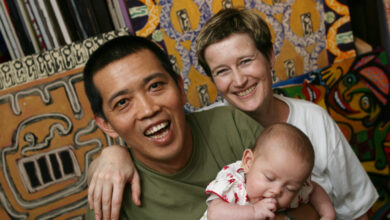Ottawa Residents Fed Up With Truckers’ Noisy and Intimidating Occupation

Just over a week has passed since a convoy of heavy trucks, pickup trucks and cars began their noisy, intimidating and unlawful, according to the police, occupation of Ottawa’s downtown core.
Now the national capital is bracing for a new wave of protesters, perhaps another 300 to 400 trucks and 2,000 people on foot while Toronto and Quebec City also anxiously await the arrival of other convoys. (My colleagues and I will be reporting through the weekend about all of those events.)

Protesters on Parliament Hill a week ago.Credit…Nasuna Stuart-Ulin for The New York Times
[Read: Canadian Trucker Convoy Descends on Ottawa to Protest Vaccine Mandates]
[Read: Justin Trudeau Condemns Convoy Protesting Pandemic Restrictions]
Most of the images and photographs of the truckers’ continued presence in Ottawa this week have come from Wellington Street, the usually busy thoroughfare in front of Parliament that’s also lined by the prime minister’s office, several offices belonging to senators and members of Parliament, the Bank of Canada, the Supreme Court, and the Library and Archives Canada building. The pandemic has meant that most of those building are largely empty these days.
But just south of there is the rest of the Centretown neighborhood, one of the most densely packed residential areas in the city. It’s a mix of high-rise apartments, condo towers, public housing, cooperative housing and beautifully restored heritage homes all plunked onto mostly narrow streets. And since the arrival of the truck convoy, the normally placid Centretown has become a congested and noisy nightmare for many residents.
“I’m receiving hundreds — and I’m not exaggerating — hundreds of emails telling me: ‘I went out to get groceries, I got yelled at, I got harassed. I got followed down the street, I’m so afraid that I can’t go out,’” Catherine McKenney, the city councilor for the area, told me on Thursday afternoon. “The residents in this downtown have just been completely abandoned during a national crisis and an occupation of our city. And there just is no urgency from the federal government, provincial government and, quite frankly, even our own police.”
Noise has been one of the greatest issues in Centretown, as well as the ByWard Market and Lowertown, the other two neighborhoods where protesters have settled in.
Day and night, trucks have been rumbling through their streets, blaring air horns — some of them of the variety usually found on railway locomotives. Impromptu fireworks shows, some as late as midnight add to the cacophony.
“The horn blaring is really meant to terrorize this community — and it’s working,” said Mx. McKenney, who will be running for mayor later this year.
Three women were celebrated by the neighborhood as local heroes of sorts when they stood in the path of a heavy truck lumbering down their street in Centretown, responding to each blast of a truck horn by turning their thumbs down.
The week has brought numerous reports of people being harangued by protesters for wearing masks, demonstrators trying to rip down pro-vaccination signs on houses and others defecating and urinating on lawns. The air on many streets is filled with diesel exhaust fumes from idling trucks.
Many local stores have temporarily closed, while those that have remained opened have struggled to enforce provincial mask rules. Over in the ByWard Market area, the Rideau Centre, an upscale mall that includes two department stores, shut its doors last weekend after being overrun by maskless protesters. It plans to stay shut until Monday. I couldn’t get a fix on how many people have been put out of work, but the Retail Council of Canada, a trade group, estimates that the closure will cost stores 19.7 million Canadian dollars in lost sales.
On Friday, Chief Peter Sloly of the Ottawa Police backed away from his previous praise for the force’s handling of the demonstrators.
“Ottawa residents are frustrated and they are angry, and they have every right to be,” he said at a news conference. “Their lives continue to be severely impacted by unlawful and unsafe events on the city streets, the downtown core and the surrounding neighborhoods. This is unacceptable.”
After earlier saying that “there may not be a police solution to this demonstration,” Mr. Sloly announced that police officials were adopting new strategies and adding additional officers to the downtown.
“The surge will deliver a clear message to the demonstrators: The lawlessness must end,” he said. “Our goal is to end the demonstrations.”
After several days of staying inside to avoid the noise and confusion, Kiavash Najafi, a Centretown resident, finally began walking through his neighborhood again with his 4-month-old daughter.
Mr. Najafi, who is on parental leave from his job at a public sector union, said that he often stopped to ask drivers clogging the neighborhood streets to shut off their engines and speak with him.
The Coronavirus Pandemic: Key Things to Know
The state of the virus in the U.S. The coronavirus has now claimed about 900,000 lives across the country, and the Covid death rates remain alarmingly high. The number of new infections, however, has fallen by more than half since mid-January, and hospitalizations are also declining.
Around the world. Several countries are easing their pandemic protocols, though public health leaders at the World Health Organization continued to urge caution about relaxing restrictions. In Austria, a sweeping Covid vaccine mandate is set to become law.
Developments in the research field. Intranasal vaccines currently under development may make better boosters by stopping the coronavirus in mucosal linings of the airways. Advancements in diagnostics ushered in by the pandemic, meanwhile, could prove crucial for reviving flagging efforts to vanquish hepatitis-C.
Staying safe. Worried about spreading Covid? Keep yourself and others safe by following some basic guidance on when to test, which mask to pick and how to use at-home virus tests. Here is what to do if you test positive for the coronavirus, and if you lose your vaccination card.
“There were older guys, they have families — they like seeing my baby,” Mr. Najafi told me. “These were not the dangerous elements that we need to worry about. And I just asked them to please leave and told them that driving us crazy and hurting the people who live in these buildings around the downtown is not exactly the best way of making a point.”
Mr. Najafi said that he found that there were many different subgroups within the protesters, and many of the people he met were far from the aggressive, hate-filled demonstrators seen in much of the footage of the protest.
Although many of the truckers he spoke to apologized, none of them took up Mr. Najafi’s suggestion to leave town.
Trans Canada
-
While dissidence over the leadership of Erin O’Toole within the Conservative Party caucus has long been apparent, the end of his time as leader came with unexpected swiftness this week.
-
The Canadian men’s soccer team defeated the United States in a qualifying match and is on the cusp of its first World Cup berth since 1986.
-
Prime Minister Justin Trudeau tested positive for the coronavirus after an exposure last week, forcing him to isolate. But he said on Twitter that he was not feeling ill.
-
With the Winter Olympics now officially underway, The Times’s fashion critic Vanessa Friedman provides an appraisal of Team Canada’s new athleisure look.
-
The Toronto author Sheila Heti explores the healing powers of love and art in her new novel, “Pure Colour.”
-
The Toronto Maple Leafs were the last N.H.L. team to allow equal access into locker rooms for female sportswriters. Robin Herman, who was a hockey reporter for The New York Times, became one of the first female journalists to break that barrier, writes Richard Sandomir. Ms. Herman, 70, died on Tuesday.
A native of Windsor, Ontario, Ian Austen was educated in Toronto, lives in Ottawa and has reported about Canada for The New York Times for the past 16 years. Follow him on Twitter at @ianrausten.
How are we doing?
We’re eager to have your thoughts about this newsletter and events in Canada in general. Please send them to [email protected].
Like this email?
Forward it to your friends, and let them know they can sign up here.





